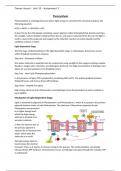Osman Yousuf – Unit 10 – Assignment 3
Photosynthesis
Photosynthesis is a biological process where light energy in converted into chemical energy by the
following equation:
6CO2 + 6H2O → C6H12O6 + 6O2
It does this by the chloroplasts containing a green pigment called chlorophyll that absorbs and traps
the sunlight. Carbon dioxide is obtained from the air, and water is obtained from the soil, the light is
used to convert this to glucose and oxygen by the reduction reaction of carbon dioxide and the
oxidation reaction of water.
Light-Dependent Stage
The first stage of photosynthesis is the light-dependent stage. In chloroplasts, the process occurs
within thylakoid membranes of grana.
Step One – Photolysis of Water
One water molecule is separated into its components using sunlight by the oxygen-evolving complex.
Results in oxygen atom, electrons, and hydrogens (protons). The high concentration of hydrogen ions
allows for a proton gradient in the thylakoid lumen.
Step Two – Non-Cyclic Photophosphorylation
In the presence of light, ATP is produced by combining ADP and Pi. The proton gradient between
thylakoid lumen and stroma drives ATP Synthase.
Step Three – NADPH Formation
High energy electrons from Photosystem I and Hydrogens from the photolysis of water combine to
form NADPH.
Mechanism of Light-Dependent Stage
Light is absorbed by pigments in Photosystem I and Photosystem II, where it is passed to the primary
pigment reaction centre of each Photosystem. The electrons of the primary pigment of each
Photosystem are promoted
to a higher energy level,
which the high-energy
electron is donated to an
acceptor molecule.
In PSII, the electron loss of
the primary pigment is
replaced by an electron from
water, which splits the
molecule as a result.
The high-energy electron
travels down the electron
transport chain, as it travels, it releases energy in the process. The proton gradient, and energy
released drives ATP Synthase, chemiosmosis occurs, as Hydrogen ions pass through the complex, ATP
is synthesised.
, Osman Yousuf – Unit 10 – Assignment 3
The electron reaches Photosystem I where it joins the special pair reaction centre, and is promoted,
and transferred to an acceptor molecule, the electron is replaced by an electron from PSII.
The high-energy electron that was donated to an acceptor molecule goes down the electron
transport chain where it is transferred to NADP+. Another electron follows the same pathway and is
also transferred. This results in the formation of NADPH 2.
Importance of Light-dependent Stage
- Water is a reactant of photosynthesis, without it, photolysis would not occur, which would
not allow the protons to drive ATP Synthase, for synthesis of ATP. This would also inhibit
formation of NADPH which is necessary for photosynthesis to continue onto the next stage.
- Light energy would not be able to convert into chemical energy in the form of ATP and
NADPH.
- Calvin Cycle is dependent on and cannot turn without the products from Light-dependent
stage.
- Production of oxygen into the atmosphere, vital for survival and life.
Light – Independent Stage
This is the second stage, occurring in the stroma (fluid surrounding Grana), is it collectively known as
the Calvin Cycle. The products of the light-dependent stages are used to produce organic molecules.
Step One – Carbon dioxide from the atmosphere diffuses into plant leaves via stomata, and travel to
the stroma. Carbon fixation occurs where one carbon dioxide molecule combines with a 5-carbon
compound Ribulose Bisphosphate (RuBP), catalysed by Ribulose Bisphosphate Carboxylase
Oxygenase (RuBisCo). When RuBP is carboxylated, it forms an unstable intermediate compound of 6
carbons. The 6-carbon compound immediately breaks down to two molecules of Glycerate-3-
Phosphate (GP/3-PGA).
Step Two – Reduction occurs. ATP from light-dependent stage is used to donate a phosphate group to
GP, in turn becoming ADP. This turns GP into a compound called 1,3-bisphosphoglycerate. This
compound is reduced by NADPH from the light-dependent stage. Each molecule gains two electrons
from NADPH and loses a phosphate group. Producing NADP+, and a 3-carbon compound called
glyceraldehyde-3-phosphate/Triose
Phosphate (G3P/TP)
Step Three – Some of the Triose
Phosphate molecules continue on to yield
glucose, and can be converted to starch,
cellulose, or sucrose. Triose Phosphate
can also be used to regenerate RuBP. 10
out of 12 TP molecules regenerate 6
molecules of RuBP.
Importance of Light-Independent Stage
- Carbon fixation occurs, where carbon dioxide is a reactant of photosynthesis, and
contributes to eliminating carbon dioxide in the atmosphere.
- Production of energy in the form of sugar (glucose), which they can use for respiration, or
making cellulose and starch.




